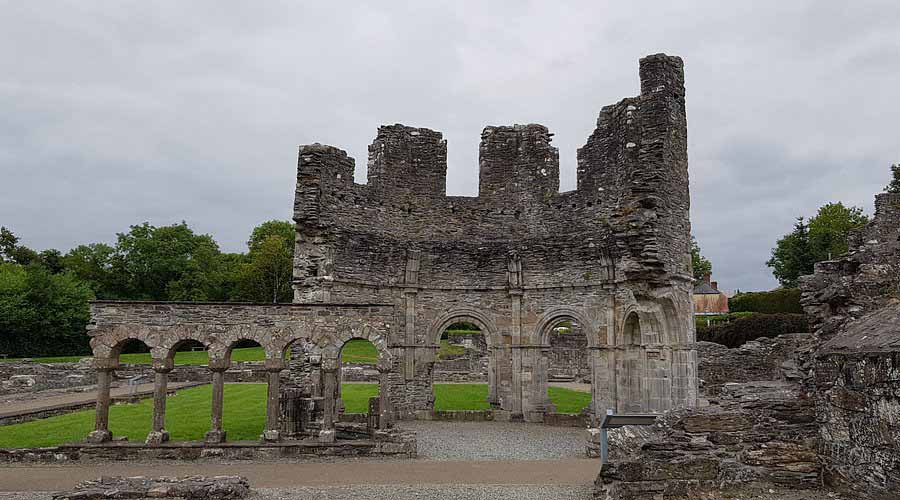
Old Mellifont Abbey, located in Tullyallen, County Louth, approximately 10 km (6 miles) northwest of Drogheda, is Ireland’s first Cistercian monastery, founded in 1142 by Saint Malachy, Archbishop of Armagh. Situated along the River Mattock in the Boyne Valley, this historic site, managed by Heritage Ireland, offers a glimpse into Ireland’s medieval monastic heritage despite its ruined state.
The abbey, once Ireland’s largest Cistercian monastery, is now largely in ruins, but its foundations reveal the scale of the original complex. Visitors can explore the outline of the cruciform abbey church (58m long, 16m wide), the cloister, chapter house, and refectory. The most striking feature is the 13th-century octagonal lavabo, a unique washroom where monks cleansed their hands before meals, featuring delicate arches and remnants of lead pipes that carried water from the river. The chapter house, partially paved with medieval glazed tiles, and Romanesque arches are also notable.
Mellifont was a pioneer of Cistercian architecture, influencing subsequent monasteries across Ireland. It hosted the Synod of Kells-Mellifont in 1152, attended by bishops and kings, and was the site of the 1603 Treaty of Mellifont, ending the Nine Years’ War. William of Orange used it as his headquarters during the 1690 Battle of the Boyne.
- Visitor Centre Exhibition: The OPW Visitor Centre features an engaging exhibition on medieval masonry, showcasing carved stones, patterned tiles, and artifacts like pottery and coins uncovered during excavations. The exhibit highlights the Cistercians’ architectural innovations and their agricultural revolution, including their role in the wool trade and land management. Visitors can hear recordings of monks’ chants, adding an atmospheric touch.
- Guided Tours: Available during the summer season (typically May to September), guided tours (40 minutes, max 35–40 people) provide detailed insights into the abbey’s history and architecture. Tours are led by knowledgeable guides who share stories of Saint Malachy, the Cistercian order, and key historical events.
- The Visitor Centre is fully accessible for visitors with disabilities, but the abbey grounds require navigating a stone stairway (14 steps with a single handrail) and gravel pathways, which may pose challenges for those with mobility issues. Suitable footwear is recommended due to uneven terrain.
- Scenic Setting: Located in the tranquil Mattock Valley, the site offers picturesque views, with the river providing a serene backdrop. The nearby gatehouse, a defensive three-story tower, adds to the historical ambiance, and a small ruined church uphill is worth a quick visit.
- Free Exploration: The abbey grounds are open year-round for free, allowing visitors to wander the ruins at their own pace outside the Visitor Centre’s operating season.
Practical Information:
- Address: Tullyallen, Drogheda, Co. Louth, A92 K682. Located 1.5 km off the R168 (Drogheda–Collon road).
- Grounds are accessible year-round. The Visitor Centre and guided tours operate from late May to mid-September (2024 dates: 23 May–18 September, 10:00 AM–5:00 PM, last admission 45 minutes before closing). Confirm 2025 hours via the Heritage Ireland website or by calling +353 41 982 6459 (summer) or Brú na Bуinne at +353 41 988 0300 (off-season).
- Admission: Grounds are free year-round. Visitor Centre and guided tours: €5 adults, €4 seniors/groups, €3 students/children (12–17), €13 families.
- Getting There: No public transport directly serves the abbey. Driving from Drogheda takes about 10 minutes, with ample free parking available. Alternatively, buses to Monasterboice Inn (Bus Éireann, +353 1 836 6111) are a 59-minute option from Dublin (€22–26).
- Nearby Attractions: Combine with visits to Monasterboice (2 miles away, known for its high crosses), the Battle of the Boyne Visitor Centre (Oldbridge), or Drogheda’s Saint Laurence’s Gate and Millmount Museum.
What’s New:
- The 2025 season will highlight the 2024 900th anniversary celebrations of the Cistercian order, with extended displays or events marking this milestone.
- Improved Accessibility: While the Visitor Centre is already accessible, ongoing efforts by Heritage Ireland to improve site accessibility may include better pathways or signage to address the challenges posed by the stone stairway and gravel surfaces. A social guide, (PDF) available on the Heritage Ireland website, helps first-time visitors, families, and those with developmental disabilities prepare for their visit, and this will be expanded or updated.
- New Guided Tour Content: Guided tours may incorporate fresh narratives, such as the role of Devorgilla, whose elopement with Dermot MacMurrough led to the Anglo-Norman invasion, as she is buried at Mellifont, or the abbey’s agricultural innovations. Tours might also emphasise the site’s connections to the 1603 Treaty of Mellifont and the Battle of the Boyne.
- Seasonal Events: Heritage Ireland may introduce new events, such as historical reenactments, lectures, or workshops, tied to the abbey’s history or the broader Boyne Valley’s cultural offerings (e.g., linking with the Sea Louth Scenic Seafood Trail or Boyne Valley Camino). Check the Heritage Ireland website or social media event announcements.
- Sustainability Initiatives: In line with Louth County Council’s sustainability efforts (e.g., Carlingford Lough Greenway), the abbey may introduce eco-friendly measures, such as improved waste management or signage promoting environmental awareness, though no specific plans are confirmed.
Recommendations
- Plan a visit between May and September to access the Visitor Centre and guided tours for a fuller experience. Off-season visits are still rewarding for exploring the grounds.
- Wear sturdy shoes for navigating the gravel paths and stairway, and bring a camera to capture the lavabo and scenic valley views.
- Check www.heritageireland.ie or the abbey’s social media updates on hours, events, or new features before visiting.
- Combine with nearby attractions like Monasterboice, Newgrange, or Drogheda’s historic sites for a comprehensive Boyne Valley experience.
- For the latest 2025 information, contact the Visitor Centre or visit the Heritage Ireland website, as schedules and offerings may change.



